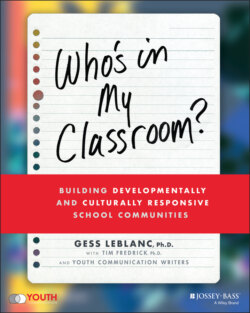Читать книгу Who's In My Classroom? - Tim Fredrick - Страница 15
Connections between Home and School Help Students Meet High Expectations
ОглавлениеSeveral scholars have discussed the importance of making connections between home culture and school as a hallmark of culturally responsive teaching.23 For example, Geneva Gay defines culturally responsive teaching as using the cultural knowledge, prior experiences, and performance styles of diverse students to make learning more appropriate and effective for them.24
More recent studies, however, have revealed that many students experience disconnects between home and school. Students experience these disconnects when their cultural beliefs and practices outside of school clash with those found in school.25 Such disconnects have been described as home-school dissonance. Dissonance is defined as the perceived differences between the values and practices present in students’ homes or out-of-school environments and those prominent throughout their formal schooling experiences.26
For example, in a study examining how such perceived dissonance influenced the emotional and academic well-being of adolescents, the researchers reported that, “Students from cultures outside the mainstream may experience a sense of dissonance when they encounter a devaluing of their beliefs and behaviors at schools that reflect the dominant White, middle-class ideology.”27 They also found that students reporting high levels of home-school dissonance also reported lower levels of academic efficacy, self-esteem, grade point average (GPA), and higher levels of anger and self-deprecation. Other researchers have also found that such dissonance is associated with lowered academic motivation and increased disruptive behavior in school.
In her book The Dreamkeepers: Successful Teachers of African American Children, Gloria Ladson-Billings describes culturally responsive teaching as a pedagogical approach that highlights the importance of making connections to students’ cultural backgrounds throughout the teaching and learning process.28 Some of the ways in which teachers demonstrate culturally responsive teaching include designing student-centered lessons, teaching in ways that make connections to students’ experiences outside of school, and having and communicating high expectations for all students.
Of course, there are countless ways to make content seem more relevant and engaging to students that also align with traditional academic goals. Here are just a few examples from students at Youth Communication. Annmarie Turnton's teacher used a connection to home culture in a way that made a classic social science concept come alive:
For 12th grade economics we examined the current value of the Haitian dollar and calculated what we already knew—that most Haitians are living below the poverty line. Ms. Casey explained Maslow's “hierarchy of needs” principle—which holds that people will only worry about higher order concerns once their basic needs have been met—and we discussed how the inability to meet the first level in Maslow's hierarchy could affect everything else in Haitian society, like literacy rates and civil and political unrest. This lesson on interrelatedness made our subject matter seem more relevant and important.
Although she demanded a lot of us, Ms. Casey was also compassionate. She told us that she was our second mother, the one who gave us life, not in the physical form, but in the mental form.
For Angelica Petela, 17, connections to her home culture and her teen culture were meaningful:
My global history teacher used to read us ethnic folk tales and make us illustrate them as though things might look back then. He made us create a social media page for an ancient person, like Cleopatra.
Ebony Coleman's English teacher made a 1957 film feel relevant to today's students:
We studied 12 Angry Men, and we had to write essays on what we'd do if we were in the characters’ shoes. It was almost as if we were in the story, and it actually led to a huge discussion.
Evin Cruz felt no connection to poetry. In fact, he “scoffed” at it, so his teacher had to scramble to find points of connection. But Evin was a New York teen who listened to rap and no doubt had elders in his extended family:
[My poetry teacher] got a spoken word poet to come to class and perform, and listening to his poem, I could visualize what he was talking about—Manhattan collapsing in on itself. He also showed us a YouTube video of a reading of Dylan Thomas's poem, “Do Not Go Gentle Into That Good Night,” about the poet's father dying—and it was like, whoa, that's dark, that's deep.
